“What I dream of is an art of balance, of purity and serenity, devoid of troubling or depressing subject matter…like a good armchair which provides relaxation from physical fatigue.” —Henri Matisse (1869-1954)
The character name of Norman Bates from Alfred Hitchcock’s “Psycho” is an oft-cited metonym employed in everything from sentencing hearings to blind-date banter, but the 1960 world had little use for it and the Best Picture Oscar was bestowed on the spear and sandal flick “Ben Hur.” The nomenclature for crazy got upped in 1973 with the release of the canonical “The Exorcist,” now a cultural meme, but the Academy shrugged and conferred the statue to “The Sting,” a popcorn movie that is referenced approximately nowhere.
The constructions of cultural reflection are weighted differently and their significance recalculated whenever a society produces a worldview dissimilar from the one that reigned when the art form underpinning those constructions was produced. That our culture has become more psychologically extreme in the beginning of the 21st century has become axiomatic, and thus nowhere do we see such a sudden rethinking of earlier visual art as we do at The Armory show this week in New York City.
The fair is spread across piers 92 and 94, as it has been for several years, but the format has migrated from one pier each for contemporary art and Modernism to five separate thematic sections. Included at this massive site are 210 galleries from 30 countries with more than 70 of them showing at The Armory for the first time, bringing a freshness to the event.
The largest section, “Galleries,” is where the heavy lifting is done. Here we have the higher end venues exhibiting expensive work, such as the James Cohan gallery, Sean Kelly, Jeffrey Deitch, and Paul Kasmin, among other major players.
Second in size is the “Insights” section, specializing in 20th century artwork, an area where visitors can glimpse our collective Modernist history. The smaller “Presents” is a section of galleries less than 10 years of age that are showing emerging artists, typically as a solo show.
“Focus” is a curated section assembled by Jarrett Gregory on a theme borrowed from the Russian book title “What Is To Be Done?” And, finally, the “Platform” section of large scale work is scattered about the fair and curated by Eric Shiner, senior vice president of Contemporary Art at Sotheby’s.
What is being reweighted at the Armory Show and elsewhere in this time of extremes in shifting worldview are the vast permutations of abstract painting and sculpture. The reweighting is perhaps a reflective balm for the unspooled, which seems to be most of us at this time, and appears throughout the latest incarnation of the show on the piers.
Abstract painting, and to some extent abstract sculpture, is favored in museums and auctions—almost suddenly—an improbable rethinking of this contemplative and soulful work that fell out of favor during the noisy and long-running show known as post-Modernism. To paraphrase B.B. King, “the shrill is gone.” More likely, we’ve become too shrill to want any more shrill.
To illustrate the rapidity and drama of this shift, consider the Jeffrey Deitch gallery included in the “Galleries” section. Below left is the current Deitch website, and on the right the gallery’s featured painting, notice the Deitch logo on the truck door is an appropriation of the ubiquitous Brillo pad box. On the left is the super-flat pop fiesta of post-Modernism and on the right a historical tome. On the left a full 4 seconds of fun and on the right a roiling picaresque that takes a fortnight to absorb. Art with a capital “A” has returned.
.
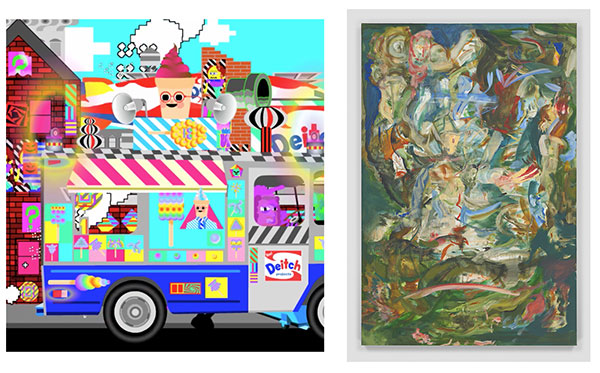
Left: screen image Deitch.com Right: “Sky Towers and Bridal Bowers” by Cecily Brown, 2016.
.
For fun, let’s run this in reverse: Below left is a 1957 painting by abstract artist James V. Harvey that would fit perfectly into Deitch’s Armory booth, and on the right the circa 1959 Brillo Pad box that Harvey himself designed on his day job. This is the box that Andy Warhol would appropriate, aka plagiarize, starting the Pop art movement that put abstract expressionists like Harvey out of business. Harvey passed in 1965, I am sure the most dumbfounded man in history, if he had stuck around he would have been, well, more dumbfounded.
.

Left: “abstract oil painting” by James V. Harvey, 1957. Right: “Brillo Pad box” by James V. Harvey, circa 1959.
.
Everywhere in The Armory visitors can see subdued, quiet, involved objects and nowhere will they see shiny post-modernism. One can comb the show and see perhaps five or six chromed-out stragglers from the Jeff Koons “banality is savior” era, but that is all. I’ve watched a hundred ton of horses suddenly bolt as if linked by a common nervous system; for reasons still unrevealed the art world has fled from pop irony.
Sean Kelly Gallery is a go-to New York gallery for edge-thinking idea art and his booth at the “Galleries” section is nearly as thrilling as his gallery. Here we see cool spirit abstract expressionist works constructed of peeling paint chips by Havana-based Diana Fonseca Quiñones. If there is one thing associated with the workers’ paradise to our south it is the flaking paint of structures not coated since Fulgencio Batista strolled La Habana Vieja.
Quiñones has put an interesting twist on work that otherwise could be viewed as a footnote to the long career of photographer Aaron Siskind, whose curling paint images posited him well within abstract expressionism. But Quiñones is working closer to the Arte Povera Italians who wished to work with nothing, the cast off, the valueless. If an aesthetic appeared, an objectification of feeling, then the object did so on its own, not in debt to the draw of a precious material.
.
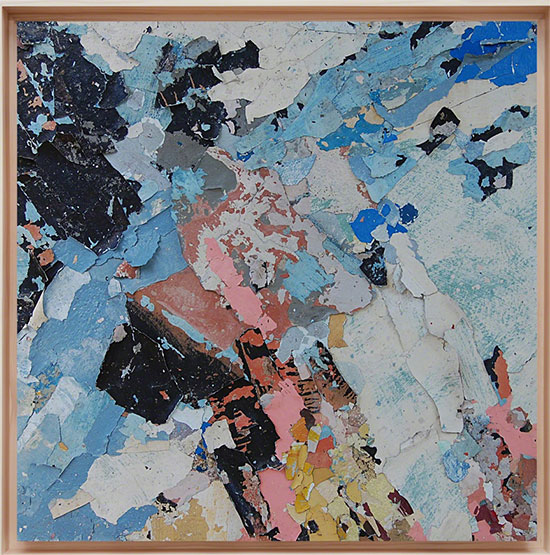
"Untitled" from the "Degradaciones" series by Diana Fonseca Quiñones, 2016. Paint fragments mounted on wood 39 3/8 × 39 3/8 inches. Exhibited with Sean Kelly Gallery.
.
Quiñones is showing similar work with the Havana gallery El Apartamento in the “Presents” section and seems to have this gallery to herself. This section of newer galleries and younger artists held no surprises other than a predilection for abstract painting and the far-flung geographies from whence these originate.
At 39, Turiya Magadlela from Soweto might not qualify as a newer artist but nonetheless she exhibits standout abstract paintings and constructions at the Blank Projects gallery from Cape Town, which has mounted a solo booth of her work. Humorously, she also works with panty hose, arriving at similar imagery to her paintings, and is having quite a career bump judging from the amount of African press about her.
.
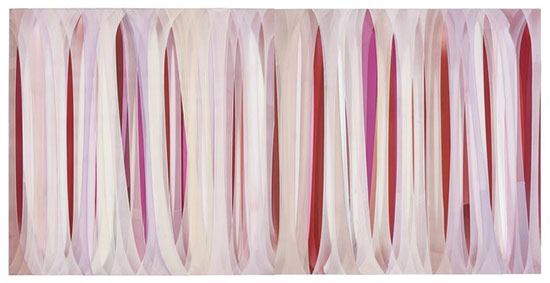
“Umjuluko, Inyembezi ne Gazi 1” (Blood, Sweat and Tears) by Turiya Magadlela, 2016. Exhibited with Blank Projects.
.

“Induku emqubeni 2” (Hidden Gems) by Turiya Magadlela, 2017. Exhibited with Blank Projects.
.
Korean artist Byung so Choi, showing with Arario Gallery, exhibits another powerful abstract work by saturating newspapers with ball point pens until the pages themselves seem to flake as paint chips. Aaron Siskind will be having a revival if this keeps up.
.

"Untitled," detail of large constructed painting by Byung so Choi, 2011. Exhibited with Arario Gallery.
.
Also at Arario, which has exhibition spaces in Seoul, Cheonan, and Shanghai, are constructed canvas works by Korean Shin Sung Hy whose method is to sculpt the canvas itself, slicing strips and then tying them into colored knots. “Constructed canvas” is another peaceful category of formalist history, circa 1970s, that seemed to come and go but now has returned.
.
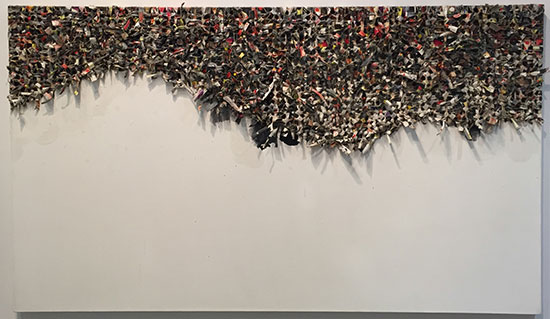
"Entrelacs" by Shin Sung Hy, 1997. Exhibited with Arario Gallery.
.
Stuart Davis was a modernist painter who infused jazz into rollicking abstractions of Times Square-like colors and chaos. There don’t seem to be many artists who continued this oeuvre, and in that absence oddly he is viewed as a pioneer of pop art, although he didn’t make any. One of the commissioned works of the “Platform” series is Towers by Douglas Coupland, constructed of Lego blocks that bring Davis-like colors and fun to a three dimensional setting, as if an animation had been performed on one of Davis’s paintings. It was a popular hit judging from the smiles on the viewers.
.
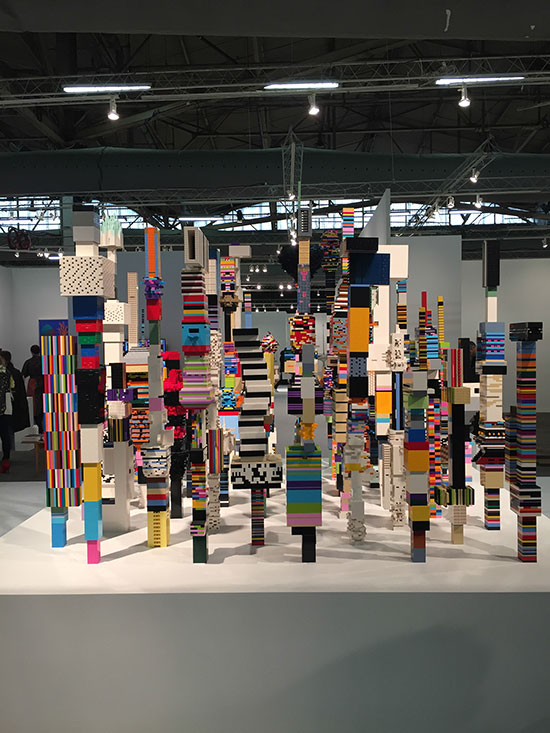
"Towers" by Douglas Coupland, 2014.
.
For several years, older artists and critics have ridiculed the return of formalist abstract art with a bevy of insults, e.g. “zombie formalism.” It seemed to be a shabby market phenomenon to fleece the nouveau connoisseur. But given the absolute volume of work produced in this area, now for a decade or so, and its manifest preference among lots of smart dealers and younger artists scattered across the globe, I have to wonder if something is afoot.
Just as Matisse sought an art “devoid of troubling or depressing subject matter,” this is precisely what we are seeing. Post-modern irony and its methods were so loud and dominant for such a long time that we forgot exactly what we were dismantling or why; it simply morphed into another virtue-signaling style, as reduced in actualization as what it portrayed. The current Armory show is a place for this reflection.
________________________________
BASIC FACTS: The Armory Show remains on view through March 5, 2017 at Piers 92 & 94, 711 12th Avenue, New York, 10019.
Hours: Thursday - Friday noon to 8 p.m., Saturday noon to 7 p.m., Sunday noon to 6 p.m.
Admission: $47 General Admission, $80 for a Run-of-Show Pass, $25-35 for a Special Pass (Students/Seniors/Groups), and $25 for Happy Hour Tickets valid Thursday or Friday from 5 to 8 p.m.
_________________________________
Copyright 2017 Hamptons Art Hub LLC. All rights reserved.
